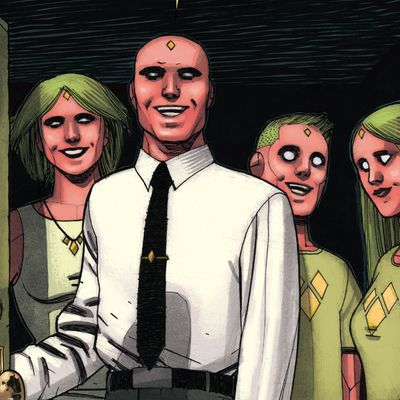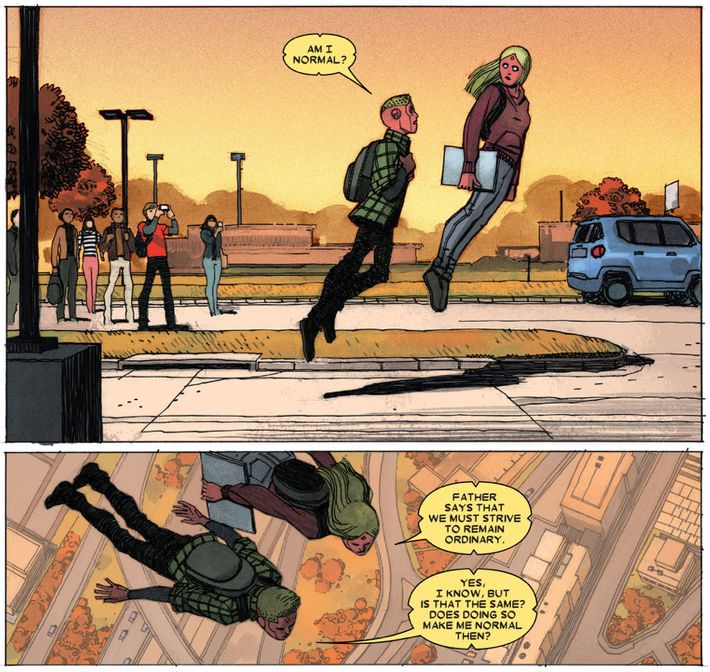
In addition to being Captain America: Civil War’s premier sweater model, Vision is also one of its standout supporting characters. The superpowered robot — played by Paul Bettany and a team of effects artists — charms us with his synthetic soul from his first appearance onscreen. He provides aesthetic delights with his gliding movement and calm, empathic face. He struggles, Spock-like, to understand the customs of us illogical humans. It’s hard to imagine walking out of the theater without swooning a little over him.
If you caught Vision Fever, you’re in luck, because there’s never been a better time to be a fan of the Avengers’ resident synthezoid. Never one to ignore a possibility for brand synergy, Marvel Entertainment launched a comics series starring Vision last year, his first in well over a decade. Written by Tom King, drawn by Gabriel Hernandez Walta, and colored by Jordie Bellaire, it’s one of the most acclaimed titles in the industry — and with good reason.
The setup of Vision is deceptively simple: Vision, in an attempt to better understand humanity, builds a synthetic wife and a pair of synthetic children, then moves to the D.C. suburbs with them. Like their creator, they stick out in a crowd with their mauve skin, lime-green hair, and stilted speech. That kind of pitch could lead to an eye-rollingly clichéd plot about how middle-class Americans treat outsiders, or at the least sound like a rehashing of the Coneheads. But although xenophobia plays a part in the story, it doesn’t dominate it, and there are no easy messages about diversity and tolerance.
Indeed, there’s very little about Vision’s underlying ideas that one could describe as easy. Like so much great fiction, the dialogue and the basic chain of events are relatively straightforward, but they spring from thematic roots that are thorny and tangled. More so than most superhero series, this one rewards repeated readings. It tackles the questions of whether or not it’s worthwhile to start a family, what it means to have an individual identity, and when a commitment to reason can lead to violence. I’ve already read it through multiple times, and I’ll admit that I’m still unsure whether I’m picking up every bit of philosophy it’s laying down.
That said, the big questions are presented in tandem with regular bursts of violent action and goosebump-inducing foreboding. Take, for example, the framing device of the sixth issue. Throughout its 19 pages, Vision’s ominous narration talks about the computer science concepts of P and NP. That discussion could be hopelessly dry. But the narrator informs you early on that you have to pay attention because P and NP inform Vision’s views of the world, and “when his hand is locked on your throat, and the jewel above his eyes begins to glow yellow … when the pain begins and you smell the unfamiliar smoke of your own burning skin … then you at least may say, ‘Of course. Of course. I understand this. I understand why I must now die.’ P vs. NP.” We have yet to find out what this coming Vision-induced disaster is, but sections like this kill you with anticipation.
While we wait to see the foretold catastrophes, we get to spend time with the Vision family, as lovable and screwed-up as any family of flesh. Vin and Viv are created to look and feel like teenagers and they spend their days struggling to figure out how to let themselves experience love, rage, and excitement without causing destruction — a struggle that anyone who’s been a teenager will remember well. Vision and his synthetic bride, Virginia, desperately want to protect their family but don’t know what to do when that responsibility conflicts with their responsibility to be good people and good citizens — again, something all parents should wonder about. By virtue of being imitations of humanity, all four of them are capable of stepping outside instinct and taking hard looks at what motivates them. Depression hangs over their dinner table, getting denser with each secret and mistake.
As you might suspect by now, Vision isn’t a cheery read. If you’re looking for the breezier aspects of the character that you saw in Civil War, you’ll only find occasional glimpses of it (there’s a particularly delightful moment that comes when Vision tries to carry on a conversation with his wife while battling a green monster named Giganto). Luckily, there are plenty of delights to be found in the artwork. Though the superheroic battles are few and far between, the visuals are still thrilling, thanks to Walta’s incredible deftness with facial expressions and Bellaire’s unparalleled gift for light and shading. Even without a single word of text, the series would still be engrossing.
And unlike most mainstream superhero series on the market today, Vision is relatively easy for comics novices to jump into, at least so far. Although there have been a few moments in the six issues to date that involve Marvel characters who haven’t appeared in the Marvel Cinematic Universe, the vast majority of the narrative just focuses on Vision and an array of brand-new characters.
Here’s the extent of what you should know that you won’t have learned from the film franchise: Vision and Wanda Maximoff — a.k.a. the Scarlet Witch — used to be married (if you detected romantic tension between the two of them in Civil War, you’re not going crazy), and Wanda was once trained by a witch named Agatha Harkness.
Oh, and there’s an African-American Captain America these days.
Now that you’ve had that brief catch-up, there’s nothing standing in your way if you want to take your Vision fandom to the next level by digging into Vision.


